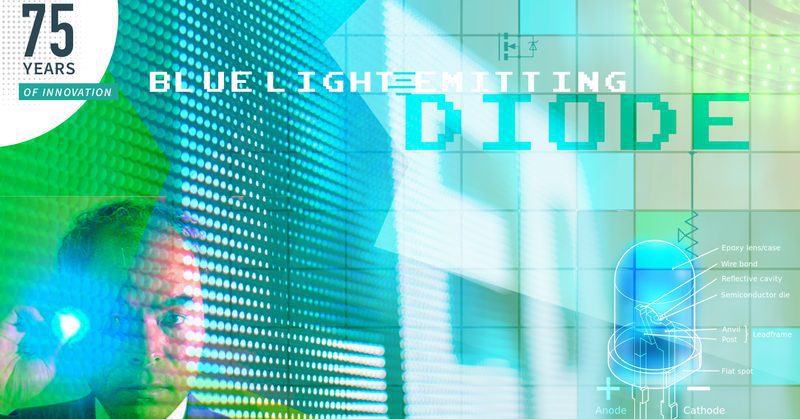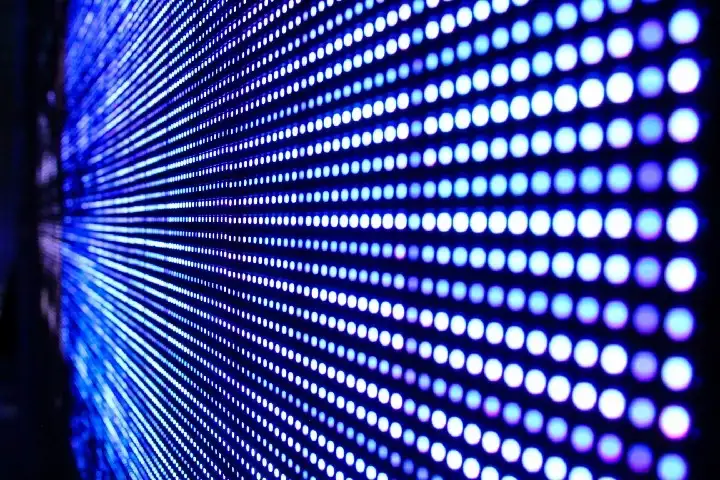Red, yellow, blue for GO! How the LED got its blue glow
The 75 Years of Innovation series highlights the groundbreaking innovations spanning from SRI’s founding in 1946 to today. Each week, SRI will release an innovation, leading up to its 75th anniversary in November 2021.

In the world of the Light Emitting Diode (LED) blue light was an elusive property. On the RGB spectrum, red and green LEDs came about more easily than blue. But having an energy efficient, blue LED, was much needed to add the breadth to the color spectrum needed to deliver consumer technologies like wall-mounted TVs.
The blue LED gave us more than just a violet-blue color; it gave us energy efficiency and a way to create white light. Having a full complement of colors brought a rainbow of opportunity to a world that used light in so many ways.
The blue LED entered the world as a technology to enable other technologies. Its story centers on a metal compound, called gallium nitride, which ultimately changed the way we look at our TVs, phones, and many other modern devices.
This is the tale of the elusive violet-blue light-emitting diode.
From Red and Green to Blue LED: How Gallium Nitride Turned Light Blue
A Light Emitting Diode is a semiconductor device. A diode is formed when there is a junction between two oppositely ‘doped’ areas:
● P (depleted in electrons) and
● N (excess electrons)
This P-N junction will only pass current when a voltage applied across it is of the correct polarity. In an LED, this will result in the emission of photons, aka light. Doping is where different elements are added to fill ‘electron holes’ to create an increased electron density that improves the effectiveness of the semiconductor.
RCA Laboratories, later known as David Sarnoff Research Center, became part of SRI International. A team, led by David Stevenson, Herbert Maruska, and others at RCA, was the first in the world to show how gallium nitride (GaN) crystals could be doped to form the basis for the violet-blue light-emitting diode or blue LED. The method that the team used to perfect the growth of the crystals is known as the ‘hydride vapor phase growth process’. The patent proposes a use for the resultant LED “An array of such devices may be used for color display systems; for example, a solid state TV screen.”
The 1974 patent by Stephenson, Rhines, and Maruska, “Gallium Nitride Metal Semiconductor Junction Light Emitting Diode” describes the process by which the team made a blue light-emitting diode. The team created a junction between undoped gallium nitride and magnesium doped gallium nitride, aka a p-type GaN film
– facilitating an electric current to flow between the two. This was the breakthrough needed to optimize gallium nitride as a semiconductor; the team used magnesium atoms to dope the gallium nitride, the final paragraph of the patent stating:
“The method of generating violet light which comprises the steps of trapping electrons in magnesium acceptors in an intrinsic gallium nitride layer, causing removal of said electrons from said acceptors by applying an electric field of sufficient magnitude to remove the electrons, and causing electrons to recombine with said magnesium acceptors whereby to generate violet light.”
This process developed at RCA belies the complexity of the problem of emitting blue light. Commercial red-light emitting diodes were developed in the early 1960s. Red LEDs used gallium arsenide phosphide (GaAsP) as the substrate for the diode; yellow emitting diodes came soon after. But blue was a color that eluded LED science. It was not until the process to grow GaN as a p-type diode substrate was conceived, that we saw violet-blue enter the diode spectrum. This use of GaN allowed lower energy frequencies to be achieved with excellent efficiency.
The Place of the Blue LED in the History of Technology
The enigma known as ‘electroluminescence’, where light is emitted from materials when an electric field is applied underpins this story. This effect was discovered in 1907 by H.J Round, assistant to Marconi. Electroluminescence is where an electrical current is applied to certain substances; the electrical energy is converted to light energy. This phenomenon is behind the development of the Light Emitting Diode.
The problem with electroluminescence was that it is not easily controlled. Work to find the perfect material for controllable light emission continued throughout the 20th century. However, it seemed that whilst red and yellow LEDs could be made, the elusive nature of blue light persisted.
At RCA in the early 1960s RCA Laboratories, Jacques Pankove reported infrared electroluminescence from gallium arsenide (GaAs) in 1962; however, GaAs was an imperfect candidate as a semiconductor. Various experiments with different substrates and doping agents followed. With light emitted as red, green, yellow and finally blue.
And, out of the blue comes the white.
Blue LEDs are incredibly efficient and offered a ground stone for the development of consumer lighting systems. They are used across myriad applications: From indicators on electrical devices to smartphone displays.

How a Blue LED Lit Up the World
Semiconductors have changed our world. The LED light has replaced the old incandescent light bulbs of the 20th century. TVs too, back in the day, were cumbersome, the ‘picture tube’ (CRT) of a color TV having to house bulky equipment. And, a CRT TV is power hungry and inefficient. The use of LEDs in TV construction revolutionized the industry, making TVs streamlined and sleek.
However, there were many steps needed to enable the semiconductors that powered the LED. The development of a process that successfully generated blue light using GaN was one such vital step. Without the foresight and tenacity of the team at RCA, lately SRI International, that little blue light may have continued to elude scientists and delayed many of our current inventions.
Next time you look at an LED TV or a flashing light on an electrical switch, stop and think about the light source it uses. And remember that a crystal of gallium nitride ultimately made it possible.
Resources
Stephenson, et. al., “Gallium Nitride Metal Semiconductor Junction Light Emitting Diode”, 1974: http://media.oregonlive.com/silicon-forest/other/blue_led_patent.pdf
Leskelä, M., et.al., Electroluminescent Phosphors, Materials Science and Materials Engineering, 2018: https://www.sciencedirect.com/science/article/pii/B0080431526004617
Maruska, H., Rhines, W., A modern perspective on the history of semiconductor nitride bluelight sources: https://www.sciencedirect.com/science/article/pii/S0038110115001318#b0020
Hu, J., et. al., Hydride vapor phase epitaxy for gallium nitride substrate, Journal of Semiconductors, 2019: https://iopscience.iop.org/article/10.1088/1674-4926/40/10/101801/meta


